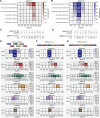Precision multiplexed base editing in human cells using Cas12a-derived base editors
- PMID: 40449999
- PMCID: PMC12126522
- DOI: 10.1038/s41467-025-59653-x
Precision multiplexed base editing in human cells using Cas12a-derived base editors
Abstract
Base editors enable the direct conversion of target nucleotides without introducing DNA double strand breaks, making them a powerful tool for creating point mutations in a human genome. However, current Cas9-derived base editing technologies have limited ability to simultaneously edit multiple loci with base-pair level precision, hindering the generation of polygenic phenotypes. Here, we test the ability of six Cas12a-derived base editing systems to process multiple gRNAs from a single transcript. We identify base editor variants capable of multiplexed base editing and improve the design of the respective gRNA array expression cassette, enabling multiplexed editing of 15 target sites in multiple human cell lines, increasing state-of-the-art in multiplexing by three-fold in the field of mammalian genome engineering. To reduce bystander mutations, we also develop a Cas12a gRNA engineering approach that directs editing outcomes towards a single base-pair conversion. We combine these advances to demonstrate that both strategies can be combined to drive multiplex base editing with greater precision and reduced bystander mutation rates. Overcoming these key obstacles of mammalian genome engineering technologies will be critical for their use in studying single nucleotide variant-associated diseases and engineering synthetic mammalian genomes.
© 2025. The Author(s).
Conflict of interest statement
Competing interests: The authors declare no competing interests.
Figures





Similar articles
-
Multiplexed conditional genome editing with Cas12a in Drosophila.Proc Natl Acad Sci U S A. 2020 Sep 15;117(37):22890-22899. doi: 10.1073/pnas.2004655117. Epub 2020 Aug 25. Proc Natl Acad Sci U S A. 2020. PMID: 32843348 Free PMC article.
-
Expanding the scope of plant genome engineering with Cas12a orthologs and highly multiplexable editing systems.Nat Commun. 2021 Mar 29;12(1):1944. doi: 10.1038/s41467-021-22330-w. Nat Commun. 2021. PMID: 33782402 Free PMC article.
-
A Survey of Genome Editing Activity for 16 Cas12a Orthologs.Keio J Med. 2020 Sep 25;69(3):59-65. doi: 10.2302/kjm.2019-0009-OA. Epub 2019 Nov 14. Keio J Med. 2020. PMID: 31723075 Free PMC article.
-
Editor's cut: DNA cleavage by CRISPR RNA-guided nucleases Cas9 and Cas12a.Biochem Soc Trans. 2020 Feb 28;48(1):207-219. doi: 10.1042/BST20190563. Biochem Soc Trans. 2020. PMID: 31872209 Free PMC article. Review.
-
Current Status and Challenges of DNA Base Editing Tools.Mol Ther. 2020 Sep 2;28(9):1938-1952. doi: 10.1016/j.ymthe.2020.07.021. Epub 2020 Jul 23. Mol Ther. 2020. PMID: 32763143 Free PMC article. Review.
References
MeSH terms
Substances
Grants and funding
LinkOut - more resources
Full Text Sources

